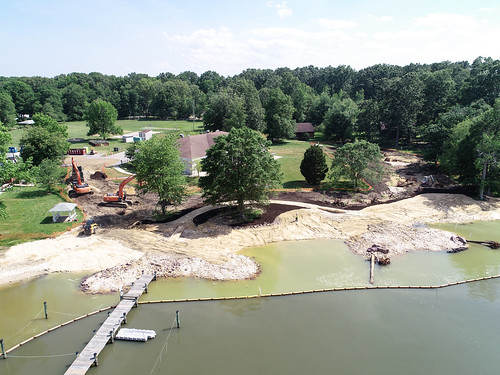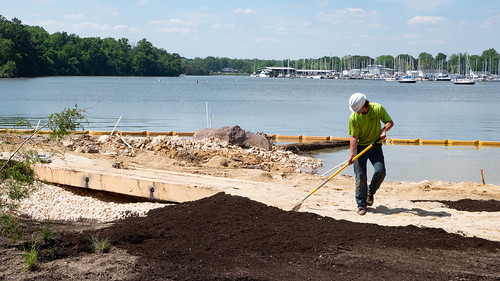Resiliency Through Restoration: Natural Defenses in a Changing Climate
 With more than 3,000 miles of shoreline, Marylanders are accustomed to living in and around water. In Annapolis and many coastal communities, high tide or “nuisance” flooding has increased dramatically since the start of the century, and scientists expect that trend to continue as rising water and sinking land impacts these low-lying areas. More frequent and stronger rain events have caused devastation and disruption in coastal and non-coastal communities alike.
With more than 3,000 miles of shoreline, Marylanders are accustomed to living in and around water. In Annapolis and many coastal communities, high tide or “nuisance” flooding has increased dramatically since the start of the century, and scientists expect that trend to continue as rising water and sinking land impacts these low-lying areas. More frequent and stronger rain events have caused devastation and disruption in coastal and non-coastal communities alike.
It feels practical to fight against nature when heavy rains, high tides, or powerful storms affect our lives and livelihoods. But as climate change impacts our communities and economies with more water and changing coastlines, we can work with nature to adapt strategically and sustainably. This is the goal of Maryland’s Resiliency through Restoration Initiative.
Maryland has long been a leader in addressing the causes and impacts of climate change. The Maryland Commission on Climate Change works diligently across state agency, legislature, local government, business, nonprofit, and academic sectors to help communities mitigate and adapt to changing conditions. With so many sectors working together, a comprehensive approach to adaptation is certainly possible.
The department follows a three-phased approach to adaptation:
• Understand Your Community’s Risk
• Plan for Future Impacts
• Implement Green Solutions
Armoring our shorelines with bulkheads or conveying stormwater directly to the Chesapeake Bay in pipes may seem like the safest options to keep water out, but in the long run, these practices are not always the best answer. They can exacerbate impacts to adjacent properties, deliver pollutants to our waterways, and reduce nearshore habitat for iconic species like blue crabs and other wildlife. Structural practices also decrease in effectiveness from the moment they are on the ground.
Where do we turn when our traditional approaches fall short? Just as nature throws us these curveballs, it also provides the very resources we need to adapt.
A Return to Nature
As our climate changes, we can expect a new kind of normal. And living in this new normal means working with – not against – nature to keep up with changing conditions. Forests, wetlands, dunes, and other natural features can buffer communities from the full impacts of waves and water. Their benefits were showcased by The Nature Conservancy following 2012’s Hurricane Sandy, when researchers estimated that wetlands reduced property damage in Maryland by 29%. These natural features can slow, absorb, and filter water if they are given the space and opportunity to thrive.
Vegetation, unlike manmade barriers, can bounce back on its own following disturbance. Natural systems collect sediment, build elevation, and migrate with water. In short, they grow and change, becoming more robust and effective over time. At the same time, these features help mitigate greenhouse gases by taking in carbon dioxide.
Acknowledging these strengths, DNR launched the Resiliency through Restoration Initiative to demonstrate how nature-based solutions can enhance community resilience to the impacts of climate change. Nature-based practices like living shorelines, restored dunes, restored wetland complexes, and rain gardens use vegetation to mimic their natural counterparts and provide a multitude of benefits.
Pilot Projects
Since 2017, the department has targeted, selected, and initiated 22 pilot projects representing different restoration practices, scales, geographies, and communities. Projects are selected to help protect community infrastructure and assets, enhance habitat, and demonstrate innovative nature-based solutions to erosion, sea level rise, storm impacts, and flooding. The department will support communities and projects through design, permitting, construction, and adaptive management. Drawing on community science volunteers and research expertise from the Chesapeake Bay National Estuarine Research Reserve, projects are being monitored to track impacts and document resilient techniques.
This summer, the first wave of pilot projects broke ground. In Anne Arundel County, the West River United Methodist Center worked with the department’s Chesapeake & Coastal Service and the Alliance for the Chesapeake Bay to construct an 885-linear-foot living shoreline to address rising tides, replace a failing bulkhead, and further protect infrastructure from storm surge and coastal impacts. Two living shoreline techniques were used to showcase different practices: vegetated headland breakwaters and a cobble beach design. In addition, two regenerative stormwater conveyance systems, or stormwater-fed wetland complexes, were included to safely convey rain water from storm events through the campus and to the shoreline. The implemented practices demonstrate multiple nature-based options for shoreline management while supporting recreational and educational opportunities for thousands of campers every year.
On the Eastern Shore, Somerset County initiated a 1,100-linear-foot living shoreline with dune restoration and offshore breakwater components to prevent a shoreline breach in the Deal Island community along Tangier Sound. Identified as a top priority by community members and researchers through the Deal Island Peninsula Partnership, this project addresses shoreline change by restoring a dunal system that disappeared after decades of erosion.
Best Management Approaches
Every community is unique and adaptation practices are as diverse as the communities that use them. Although nature can provide additional security for communities grappling with flooding, erosion, and other climate impacts, water must go somewhere. Every system, natural or manmade, has its limits.
Space, size, and cost are crucial elements to consider when exploring natural solutions and nature-based solutions may not work everywhere. In fact, nature may be just one piece of a very large puzzle for communities adapting to changing conditions. How developed is the area at risk? Is there space for a natural approach? Will infrastructure need to be moved? How often would a hardened solution need to be replaced? What are the short- and long-term costs of different options? The answers to these questions can provide perspective on the practicality of a nature-based or more traditional approach. In many cases, a hybrid solution that merges natural with structural components may be the most effective.
No matter where your community is in the adaptation process, you can take steps toward resiliency and learn about best management practices to work with nature. The department’s Grants Gateway provides an opportunity to explore and submit ideas for restoration and resilience projects in your community.
dnr.maryland.gov/ccs/Pages/funding/grantsgateway.aspx
Nicole Carlozo is a Natural Resources Planner with the Maryland Department of Natural Resources Chesapeake and Coastal Service. She manages the Resiliency through Restoration Initiative. Article appears in Vol. 24, No. 4 of the Maryland Natural Resource magazine, fall 2021.



 1-888-373-7888
1-888-373-7888 233733
233733